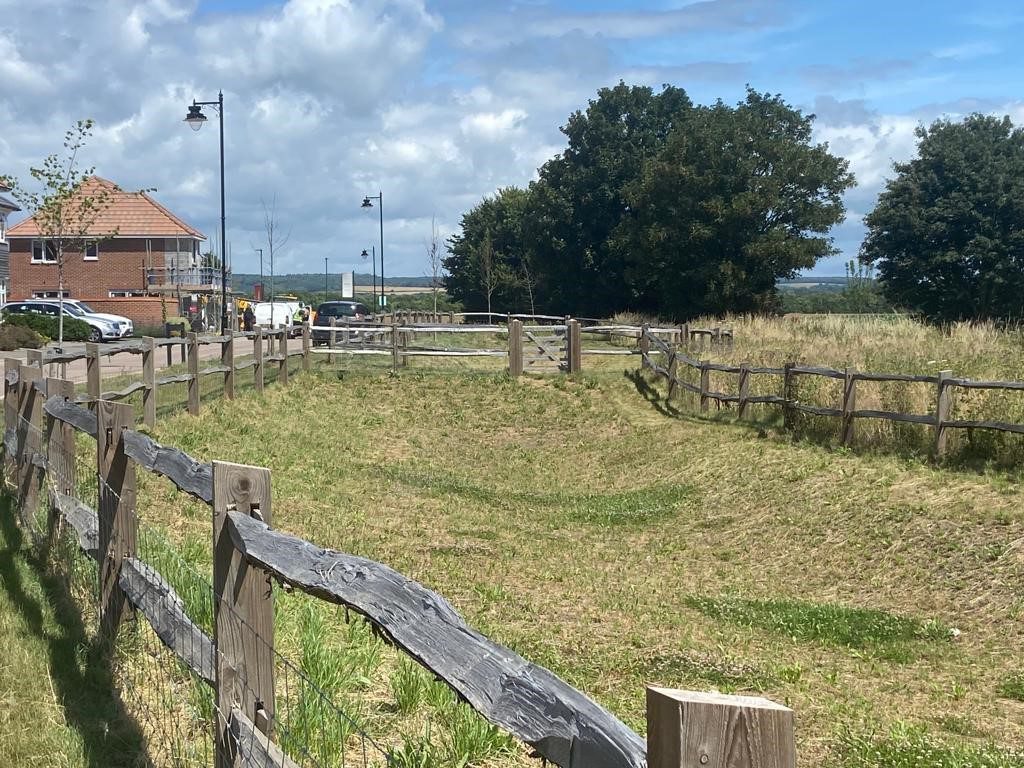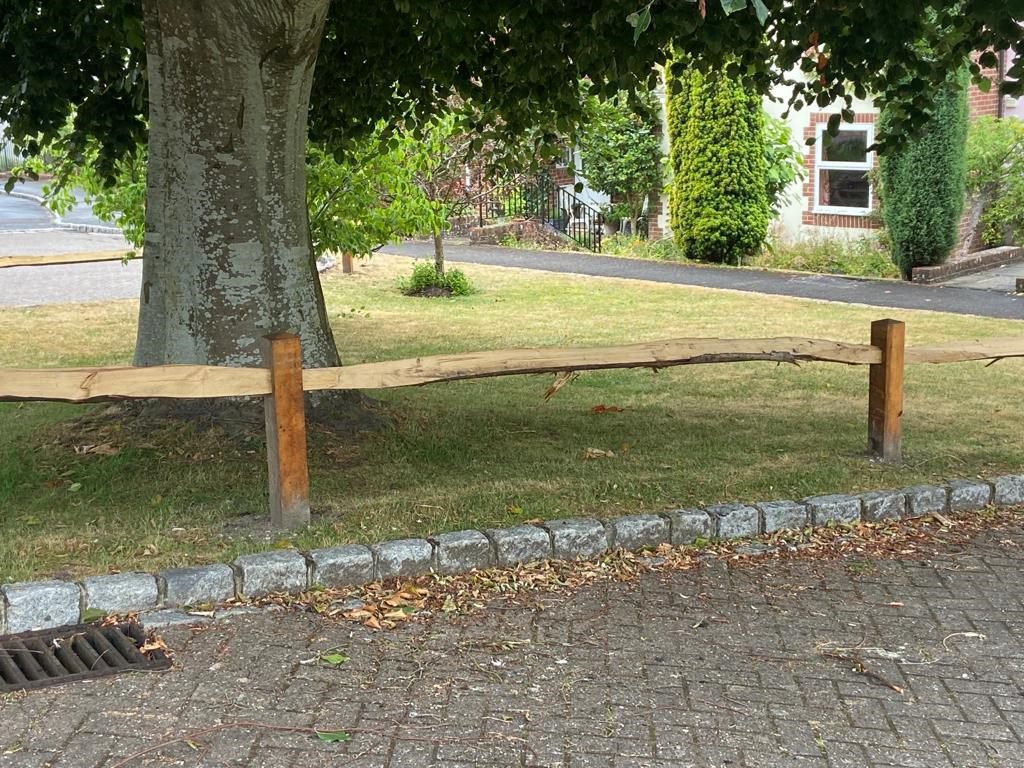Traditional chestnut cleft rail fencing (also known as Sussex Rail) has been used for centuries for gardens, paddocks, stock enclosures and agricultural land. In this blog, our expert fencing division provide a step-by-step guide to help you decide whether this style of fencing offers the right solution for your needs. Keep reading to find out more.
What is Chestnut Cleft Rail Fencing?
Chestnut cleft rail fencing is renowned for its seamless integration into natural surroundings, offering a durable, robust and visually appealing rustic fence option. Unlike sawn rails, chestnut “cleft” or “riven” rails are split, resulting in an organic and non-uniform appearance. These fences are available in various heights, allowing for customisation with one, two, three, or four rails. Further, all options have a use, depending on the desired aesthetic and functional requirements.
At W L West & Sons Ltd, we source our chestnut primarily from coppices located on the Cowdray Estate in Midhurst, West Sussex. This choice of timber ensures sustainability as the trees are regrown for future harvests, making it an environmentally friendly option with a significantly reduced carbon footprint. Therefore, you can feel reassured that when you’re investing in fencing materials and services through us, you’re also doing your bit for the planet.
How is a cleft rail fence constructed?
Cleft rail fences, also known as chestnut fences, are constructed using split logs that come in a standard length of 9 feet 6 inches. Commonly, these logs have pre-shaped ends that fit snugly into mortices in the fence posts. This design allows the rails to easily slot into the timber posts. The construction method of cleft rail fences makes them particularly suitable for areas with sloping or uneven terrain. Since all the posts are inserted at the same height from the ground, the rails can follow the natural slope of the land between each set of posts.
Typically, morticed fence posts have two adjacent holes on each side, allowing the rails to be fully inserted and securely fitted. The number of rows of rails can vary, with posts designed to accommodate one, two, three, or four rows.
For agricultural applications, cleft rail fencing can be combined with galvanised stock fences. This combination creates an open yet secure fencing system.
Top tip: when installing cleft rails, it’s best to place them with the bark side down and the split side facing upwards. This positioning ensures a sturdy and visually appealing fence.

Your Cleft Rail Fencing Frequently Asked Questions
What wood is best for cleft rail fence posts?
When it comes to selecting wood for fence posts, two popular options are oak and pressure-treated softwood.
Oak posts, typically measuring 125mm x 100mm, are a sturdy and durable choice. They are known for their strength and longevity, making them suitable for supporting the weight of the fence and enduring outdoor conditions. Oak posts often have a twice weathered and morticed top, providing added stability and a traditional aesthetic.
Alternatively, pressure-treated softwood posts measuring 150mm x 75mm are another viable option. These posts are treated with preservatives to protect against rot, decay and insect damage, enhancing their longevity and resistance to weathering. Softwood posts usually feature a back weathered top, which helps shed water and minimise the risk of moisture damage.
Do I need to concrete in a cleft rail fence?
In general, cleft rail fencing can be installed using the backfill method, which involves digging the hole, positioning the fence post, before backfilling the hole with the excavated soil, compacting it to secure the post. This method is commonly used and can provide sufficient stability for the fence.
Alternatively, if you are using pointed fence posts, they can be driven directly into the ground using a manual post rammer or a petrol post rammer (which can be hired). This method eliminates the need for concrete.
However, there are certain circumstances where concreting the fence posts may be necessary. If the ground is soft or unstable, or if the fence is expected to withstand significant forces such as strong winds or heavy usage, concrete can provide additional strength and stability to the fence posts. Concrete is especially useful when dealing with challenging soil conditions or when erecting a fence in areas prone to shifting or settling.
What depth should the post hole be?
The standard depth for post holes in cleft rail fencing is typically around 600 millimetres (or 2 feet). This depth provides sufficient stability and support for the fence posts. However, it’s worth noting that the specific depth may vary depending on various factors, including the soil conditions, climate, and local building codes or regulations.
In some cases, particularly in areas with softer soil or areas prone to frost heave, it may be necessary to dig post holes deeper than the standard depth to ensure the stability of the fence. However, if the soil is exceptionally rocky or compacted, it may be challenging to achieve the full standard depth.
A cleft rail fence typically has a standard height of 1.2 metres (or 4 feet). This height is commonly used for such fences. However, it is also possible to construct cleft rail fences with a height of up to 1.5 metres (or 5 feet) if desired or if specific requirements call for a taller fence.
In addition to the standard height, there is also a style of cleft rail fence known as a single rail fence, which is typically around 45 centimetres (or 18 inches) in height. This style offers a lower profile and may be suitable for certain applications or aesthetic preferences.
Do you need to treat the wood?
Because oak and chestnut are naturally very hardy and strong, they can be used for fencing without the need for treating. If you use pressure treated softwood posts they have been pre-treated and will not require further treatment.
How far apart do cleft fencing posts need to be ?
The recommended spacing between cleft fencing posts is typically around 2.75 metres (or 9 feet) measured from the centre of one post to the centre of the next. This spacing ensures proper support and stability for the rails while maintaining structural integrity.
How long will cleft rail fence posts last?
The longevity of fence posts can vary depending on the type of wood used and the conditions they are exposed to. Typically, pressure-treated softwood posts are treated with preservatives to enhance their durability and resistance to decay and insect damage. On average, pressure-treated softwood posts have a desired lifespan of around 15 years. However, with proper maintenance and care, they can sometimes last longer.
On the other hand, oak is a hardwood known for its strength and durability. When used as fence posts, oak can have a lifespan of up to 40 years or more, depending on factors such as soil conditions and proper maintenance. Oak posts are naturally more resistant to rot and decay compared to softwood posts.
It’s important to note that these lifespans are estimates and can vary based on factors such as the quality of the wood, environmental conditions (such as exposure to moisture and sunlight) and regular maintenance practices.
Fencing supply and installation in West Sussex and the surrounding areas
Do you need support with supplies or a fencing project in West Sussex or the surrounding areas? Contact PRO Fencing, experienced fencing suppliers and contractors with a wealth of knowledge in the fencing field. Drop us an email or get in touch today. Alternatively, give us a call on: 01252 726391.
WL West & Sons Ltd is a timber merchant and sawmill business with 150 years of experience. We provide a wide range of air-dried oak and kiln-dried oak timber products and supplies. We also build and install custom projects for our customers.
Our wood products, building materials and certified wood are manufactured and sold with the endorsement of forest certification and the Forest Stewardship Council FSC
For more news, tips and updates, follow us on Facebook, Twitter, or Instagram.
For entirely finished products, timber supplies or woodworking tools, have a look at our Retail Shop.



